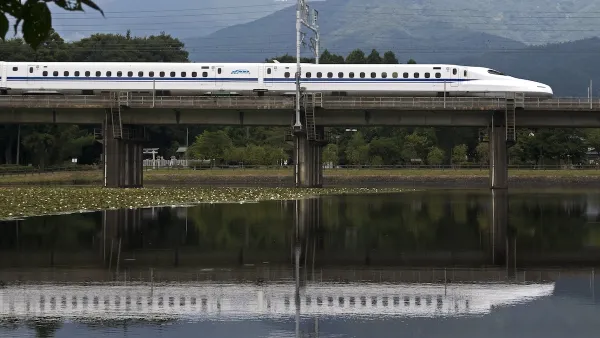Anthony Flint of the Lincoln Institute of Land Policy says the way to save high-speed rail policy is to focus on getting the two trains with the best chance of success on track.
The Lincoln Institute of Land Policy recently released a new report, High-Speed Rail: International Lessons for U.S. Policy Makers. The report says explains why it is a good idea to focus on California and the Northeast:
"These are connections between major cities that are too short to fly, and too long to drive, and could potentially open up labor markets in much the same way it works between cities in Europe. The projects are ambitious, face alignment challenges, and are not cheap – $50 billion for California (approved by citizens in a ballot question) and potentially $100 billion for a Northeast corridor replacement of the Acela, using new tracks in Connecticut and Massachusetts. But they promise a return on investment, as the international experience shows, and would create lots of jobs – 450,000 jobs through 2035 in California, according to that state's HSR Authority, and 44,000 jobs annually over 25 years plus 120,000 permanent jobs for the Northeast corridor, according to Amtrak."
For more coverage of high-speed rail, visit our sister site, The Railist.
FULL STORY: Can High Speed Rail Be Saved?

Planetizen Federal Action Tracker
A weekly monitor of how Trump’s orders and actions are impacting planners and planning in America.

San Francisco's School District Spent $105M To Build Affordable Housing for Teachers — And That's Just the Beginning
SFUSD joins a growing list of school districts using their land holdings to address housing affordability challenges faced by their own employees.

The Tiny, Adorable $7,000 Car Turning Japan Onto EVs
The single seat Mibot charges from a regular plug as quickly as an iPad, and is about half the price of an average EV.

Seattle's Plan for Adopting Driverless Cars
Equity, safety, accessibility and affordability are front of mind as the city prepares for robotaxis and other autonomous vehicles.

As Trump Phases Out FEMA, Is It Time to Flee the Floodplains?
With less federal funding available for disaster relief efforts, the need to relocate at-risk communities is more urgent than ever.

With Protected Lanes, 460% More People Commute by Bike
For those needing more ammo, more data proving what we already knew is here.
Urban Design for Planners 1: Software Tools
This six-course series explores essential urban design concepts using open source software and equips planners with the tools they need to participate fully in the urban design process.
Planning for Universal Design
Learn the tools for implementing Universal Design in planning regulations.
Smith Gee Studio
City of Charlotte
City of Camden Redevelopment Agency
City of Astoria
Transportation Research & Education Center (TREC) at Portland State University
US High Speed Rail Association
City of Camden Redevelopment Agency
Municipality of Princeton (NJ)





























